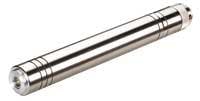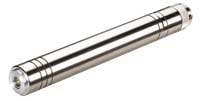DARPA looks to Sensors Unlimited for dual-wavelength focal-plane array
Sensors Unlimited Inc. in Princeton, N.J., won a contract from the U.S. Defense Advanced Research Projects Agency (DARPA) Microsystems Technology Office (MTO) in Arlington, Va., to develop a 1280-by-1024-pixel, dual-wavelength, visible and shortwave-infrared focal-plane array (FPA). The uncooled, InGaAs array will enable high-resolution, passive night-vision imaging with sensitivity to wavelengths from 0.4 to 1.7 microns using pixels on a 15-micron pitch. The contract will be awarded in three, 12-month phases and if fully executed, will total nearly $4.6 million. The development of this FPA will result in breakthrough advances in focal-plane-array performance. The new FPA will have less than 10 electrons readout noise while operating at video rates. For more information contact Sensors Unlimited online at www.sensorsinc.com.
StockerYale offers double-clad ytterbium fiber for fiber-laser applications
StockerYale Inc. in Salem, N.H., is introducing ytterbium (Yb)-doped fiber for fiber lasers, which are gradually replacing conventional Nd:YAG lasers in applications such as laser marking, material processing, welding, surgery, and free-space communications. “Due to recent technological advances, fiber lasers are expected to capture an increasing percentage of the industrial laser market,” says Mark W. Blodgett, chairman and chief executive officer of StockerYale. “Unlike solution doping, StockerYale’s proprietary rare-earth doping process provides for high quantum efficiency and high rare-earth concentration because of more-uniform homogenization of rare earth into the glass matrix, adds Rick Tumminelli, StockerYale’s manager of specialty-fiber operations. For more information contact StockerYale online at www.stockeryale.com.
Newport unveils ultraviolet refractive beam shaper
Newport Corp. in Irvine, Calif., introduced the GBS-UV-H refractive beam shaper. Optically designed without an internal focus for higher-energy pulsed and CW lasers, the device is optimized for ultraviolet (UV) laser input at 248 to 365 nanometers. The shaper delivers efficient beam shaping necessary for applications such as material processing, micromachining, annealing, lithography, nonlinear optics, optical data storage, and cell sorting. The device’s “refractive design enables customers to convert a Gaussian laser beam into a collimated flattop beam with nearly 100 percent efficiency,” says Steve Peterson, product manager for optomechanics and subassemblies at Newport. The shaper produces a collimated flattop beam by point-to-point mapping of the Gaussian input rays to redistribute the intensity to a flat-top output. The collimated output beam can be easily manipulated and resized with conventional imaging optics. The device uses low dispersion refractive optics with high-efficiency dielectric antireflective coatings. For more information contact Newport online at www.newport.come/UVbeamshaper.
Navy turns to IPG for 10-kilowatt fiber laser
U.S. Navy officials are buying a 10-kilowatt continuous-wave ytterbium fiber-laser system from IPG Photonics Corp. in Oxford, Mass. The Navy purchased the YLR-10000 with central emission wavelength of 1070 nanometers. The unit is water-cooled and delivers its output through a 20-meter flexible fiber. The commercial procurement contract was awarded by the Naval Surface Warfare Center in Crane, Ind. For more information contact IPG online at www.ipgphotonics.com.
Navy picks Kollmorgen for optoelectronic sensor systems
Kollmorgen Electro-Optical of Northampton, Mass., is providing the U.S. Navy two separate versions of the company’s MK 46 optical sight systems. Kollmorgen won a $3.7 million contract for its SeaScout Electro-Optical Surveillance Systems (EOSS), which is a stabilized imaging system that provides 360-degree day and night surveillance. Sea Scout is a lighter and more compact version of Kollmorgen’s older MK 46 optical system, which is aboard more the 50 U.S. naval platforms. The system includes high-resolution color day imaging, multi-field-of-view night vision, automatic perimeter scanning, image tracking, and an eye-safe laser rangefinder. Kollmorgen also won a $13.8 million contract to provide 11 MK 46 systems, The MK 46 is an optoelectronic sensor system that provides day & night vision capabilities for the U.S. Navy’s Arleigh Burke class destroyers. The MK 46 OSS enables 24-hour surveillance, intelligence gathering and reconnaissance. For more information contact Kollmorgen online at www.eo.kollmorgen.com.
Axsys Technologies receives $4.4 million order for infrared imaging lenses
Axsys Technologies Inc. in Rocky Hill, Conn., won a $4.4 million order to produce dual-field-of-view infrared imaging lenses for an advanced U.S. Army armored vehicle. These high-performance lenses will enable vehicle operators to carry out all-weather missions, day or night. The order specifies product delivery over the next year. Axsys makes precision optical solutions for high technology applications, serving the aerospace, defense and high performance commercial markets. For more information contact the company online at www.axsys.com.
DRS to provide infrared assemblies for Apache helicopter Arrowhead system
DRS Technologies Inc. in Parsippany, N.J., won $30 million in new orders to produce infrared targeting receiver assemblies for the Apache Arrowhead forward looking infrared (FLIR) system for U.S. Army AH-64 attack helicopters and the British Army’s AH MK 1 helicopters. The orders represent Lot 2 production of the Arrowhead, the U.S. Army’s Modernized Target Acquisition and Designation Sight/Pilot Night Vision Sensor (MTADS/PNVS) system, and initial production to upgrade the United Kingdom’s Apache air fleet. Awarding the contracts is the Lockheed Martin Corp Missiles and Fire Control in Orlando. The DRS Infrared Technologies unit in Dallas will provide Standard Advanced Dewar Assemblies Type I (SADA I) units, which are infrared detector and cryogenic cooler assemblies. Deliveries are to be completed by June 2007. The Apache Arrowhead generates a high-resolution image from the pilotage FLIR sensor that displays in the cockpit and on the pilot’s helmet-mounted display. The U.S. Army is expected to purchase more than 700 Arrowhead systems to outfit its AH-64 Apache fleet by 2009.
Edmund Optics offers clear-optical-path USAF targets
Edmund Optics in Barrington, New Jersey is releasing the new Clear Optical Path USAF targets, manufactured from an extremely thin electroformed nickel substrate. Because there is no glass in the pattern area, light travels only through air, eliminating chromatic and absorption issues. The target pattern covers from group 0, element 1, to group 3, element 6. A user card is included to illustrate where each group and element is located. The target can be used for very deep ultraviolet, x-ray and far-infrared applications. For more information contact Edmund online at www.edmundoptics.com.
Air Force chooses Nufern for high-power fiber amplifier
U.S. Air Force officials say they will award a sole-source contract to Nufern Inc. in East Granby, Conn., for a high-average-power fiber amplifier. No dollar value was disclosed. The amplifier, which Air Force officials say is not available elsewhere, must be able to handle power as high as 100 watts, and incorporate a built-in pump combiner. The contract will come from the Air Force Materiel Command at Wright-Patterson Air Force Base in Dayton, Ohio. Air Force officials made the announcement in August. More information on this procurement is online at www.pixs.wpafb.af.mil/pixslibr/05T0198/05T0198.asp.
Optical Cable earns two DOD optical fiber certifications
Optical Cable Corp. in Roanoke, Va., earned U.S. Department of Defense (DOD) certification as a qualified supplier of ground tactical fiber-optic cable. The company now meets the guidelines of MIL-PRF-85045/8A, company officials say. The Defense Supply Center Columbus (DSCC) in Columbus, Ohio, verified that Optical Cable passed a series of optical, environmental, and mechanical tests as defined in MIL-PRF-85045/8A. Optical Cable’s manufacturing facility also earned DOD certification as a MIL-STD-790F facility, which requires compliance with government requirements for product design, documentation, process control, and management practices. “Optical Cable Corporation’s military-grade fiber-optic cables are currently deployed worldwide by the U.S. military in every significant operational theater, providing secure and reliable tactical communications,” says Barney Dean, Optical Cable’s military and government sales manager. For more information see www.occfiber.com.
Sabeus opens optical-fiber plant for military and other federal users
Sabeus Inc. in Calabasas, Calif., is opening a 15,000-square-foot production and research facility in Freeport, Pa., for fiber-optic systems for acoustic sensing, intrusion detection, and surveillance applications. The Sabeus Federal Systems division will be based in the new facility located in the Northpointe Technology Center, 27 miles north of Pittsburgh. Federal Systems will build advanced fiber-optic intrusion detection and surveillance systems. Sabeus has installed at Northpointe a state-of-the-art fiber-optic manufacturing center to automate the production of its proprietary embedded sensors and fiber coatings. Sabeus sensing systems are designed to meet the stringent requirements of the U.S. Navy for undersea surveillance applications. For more information contact Sabeus online at www.sabeus.com.
KVH receives $3.2 million order for fiber-optic-gyro-based systems
KVH Industries Inc. in Middletown, R.I., received a $3.2 million order for its fiber-optic-gyro (FOG)-based TG-6000 precision inertial measurement unit (IMU). The order came from Raytheon Integrated Defense Systems. The TG-6000 IMU will serve as a key component in the guidance system of the U.S. Navy’s next-generation MK 54 lightweight torpedoes. Delivery of the TG-6000 IMUs ordered during this initial contract will begin later in 2005 and continue through 2007. If three follow-on options are exercised, the total order is potentially worth more than $15.8 million between 2005 and 2009. The KVH TG-6000 measures rate and acceleration precisely in three dimensions, critical for the navigation of a torpedo or other smart munitions. The IMU uses a three-axis configuration of KVH’s FOGs, which have an all-fiber design and digital signal processing for reliability and accuracy. The MK 54 lightweight torpedo is the next-generation antisubmarine-warfare (ASW) weapon. For more information contact KVH online at www.fiberopticgyro.com.
OIP Sensor Systems delivers military night-vision systems
OIP Sensor Systems in Oudenaarde, Belgium, won two separate contracts to deliver military night-vision systems in Europe and in South America. OIP won a contract from an unspecified South American country for 100 driver night vision viewers for armored personnel carriers. Drivers of closed-hatch vehicles benefit from clear daylight viewing conditions at night with OIP’s night-vision viewer. The display viewer with integrated imaging intensifier tube provides the driver with passive driving capability at night. Separately, OIP won a contract to build 500 LORIS night-vision monocular sights from an undisclosed European customer. The sights are being delivered with Photonis-DEP’s high quality XD-4 as well as its XR-5 image intensifier tubes. Deliveries are scheduled for the end of this year. For more information contact OIP online at www.oip.be.




